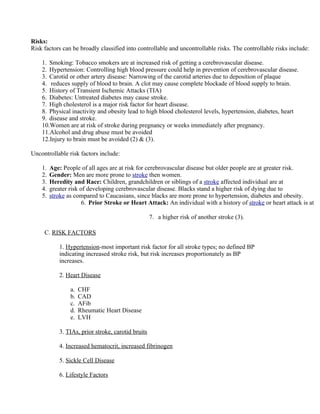Recommended
Recommended
Cardio Vascular Health challenges in presenting century Cardio Vascular Health challenges in presenting century 

Cardio Vascular Health challenges in presenting century Tarika Sharma, Lecturer, CON, ILBS, New Delhi
More Related Content
What's hot
Cardio Vascular Health challenges in presenting century Cardio Vascular Health challenges in presenting century 

Cardio Vascular Health challenges in presenting century Tarika Sharma, Lecturer, CON, ILBS, New Delhi
What's hot (20)
HMC- Common Nutrition-Related Diseases (20 minutes)

HMC- Common Nutrition-Related Diseases (20 minutes)
Cardio Vascular Health challenges in presenting century 

Cardio Vascular Health challenges in presenting century
Cardiovascular Disease (CVD) Preventing & Controlling

Cardiovascular Disease (CVD) Preventing & Controlling
Grade 7 - Diseases (Communicable and Non-communicable Diseases) part 2

Grade 7 - Diseases (Communicable and Non-communicable Diseases) part 2
Similar to Nm
Similar to Nm (20)
What Cancer Patients Need to Know about Cardio-Oncology

What Cancer Patients Need to Know about Cardio-Oncology
Heirlooms, Hope Chests and Genes...What did you inherit?

Heirlooms, Hope Chests and Genes...What did you inherit?
Nm
- 1. Risks: Risk factors can be broadly classified into controllable and uncontrollable risks. The controllable risks include: 1. Smoking: Tobacco smokers are at increased risk of getting a cerebrovascular disease. 2. Hypertension: Controlling high blood pressure could help in prevention of cerebrovascular disease. 3. Carotid or other artery disease: Narrowing of the carotid arteries due to deposition of plaque 4. reduces supply of blood to brain. A clot may cause complete blockade of blood supply to brain. 5. History of Transient Ischemic Attacks (TIA) 6. Diabetes: Untreated diabetes may cause stroke. 7. High cholesterol is a major risk factor for heart disease. 8. Physical inactivity and obesity lead to high blood cholesterol levels, hypertension, diabetes, heart 9. disease and stroke. 10.Women are at risk of stroke during pregnancy or weeks immediately after pregnancy. 11.Alcohol and drug abuse must be avoided 12.Injury to brain must be avoided (2) & (3). Uncontrollable risk factors include: 1. Age: People of all ages are at risk for cerebrovascular disease but older people are at greater risk. 2. Gender: Men are more prone to stroke then women. 3. Heredity and Race: Children, grandchildren or siblings of a stroke affected individual are at 4. greater risk of developing cerebrovascular disease. Blacks stand a higher risk of dying due to 5. stroke as compared to Caucasians, since blacks are more prone to hypertension, diabetes and obesity. 6. Prior Stroke or Heart Attack: An individual with a history of stroke or heart attack is at 7. a higher risk of another stroke (3). C. RISK FACTORS 1. Hypertension-most important risk factor for all stroke types; no defined BP indicating increased stroke risk, but risk increases proportionately as BP increases. 2. Heart Disease a. CHF b. CAD c. AFib d. Rheumatic Heart Disease e. LVH 3. TIAs, prior stroke, carotid bruits 4. Increased hematocrit, increased fibrinogen 5. Sickle Cell Disease 6. Lifestyle Factors
- 2. a. Age (older) b. Alcohol abuse c. Cigarette smoking d. Drug abuse e. Genetic factors f. Males 7. Diabetes Mellitus 8. Migraine HA’s 9. Retinal emboli
